This post may contains affiliate links. Read our full disclosure here.
The Easy Dandelion Wine Recipe connects us to centuries of herbal wisdom and backyard craftsmanship. When spring arrives and those golden flowers dot lawns everywhere, I find myself reaching for mason jars and sugar, ready to transform what most consider weeds into something extraordinary. This ancient practice of floral fermentation dates back generations, when resourceful folks made alcohol from whatever grew abundantly around them.
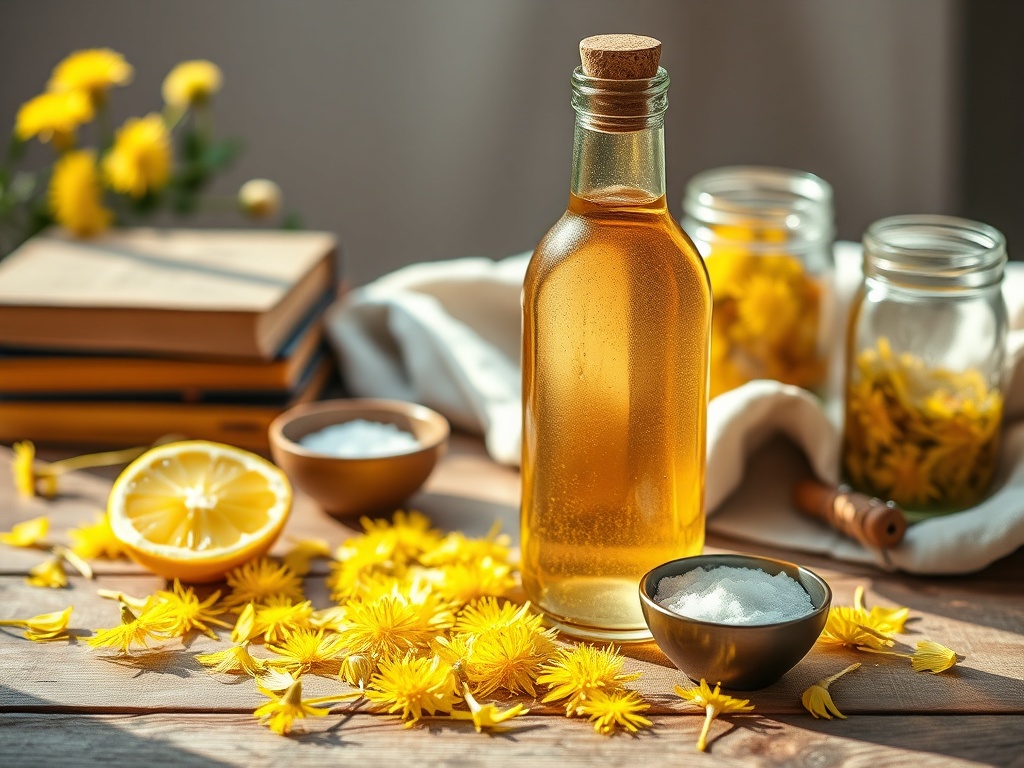
My grandmother first taught me this recipe, passed down through her family from the hills of Appalachia. The beauty of dandelion wine lies in its simplicity—just petals, citrus, sugar, and time. The result? A golden elixir that captures sunshine in liquid form with a taste unlike any commercial wine you’ll find. This Easy Dandelion Wine Recipe isn’t just a drink—it’s a connection to seasons, traditions, and the surprising bounty that grows right under our feet.
What Is Dandelion Wine?

Dandelion wine is a homemade floral fermented beverage created from the bright yellow petals of common dandelions. Unlike grape wines, this herbal brew originates from European folk traditions and Appalachian homesteading practices. When my friend Sarah visited her grandmother in rural Kentucky, she discovered old recipe cards detailing this exact process—proof that this tradition spans continents and generations.
The Easy Dandelion Wine Recipe relies on just the yellow petals (no green parts) to create a surprisingly complex flavor profile. The taste lands somewhere between honey, herbs, and a light white wine—distinctly floral with earthy undertones. What makes it special is that dandelions grow virtually everywhere, making this possibly the most accessible homemade wine on the planet.
“A wine made of weeds reminds us that beauty—and flavor—grows underfoot.”
This slow-craft seasonal drink depends entirely on timing with nature’s bloom cycle. You’ll need to harvest in spring when dandelions are plentiful, then allow months for proper fermentation and aging. Unlike commercial wines, each batch varies slightly depending on your local dandelions, the weather that season, and your particular brewing method.
Why This Ancient Herbal Wine Recipe Still Speaks to Us
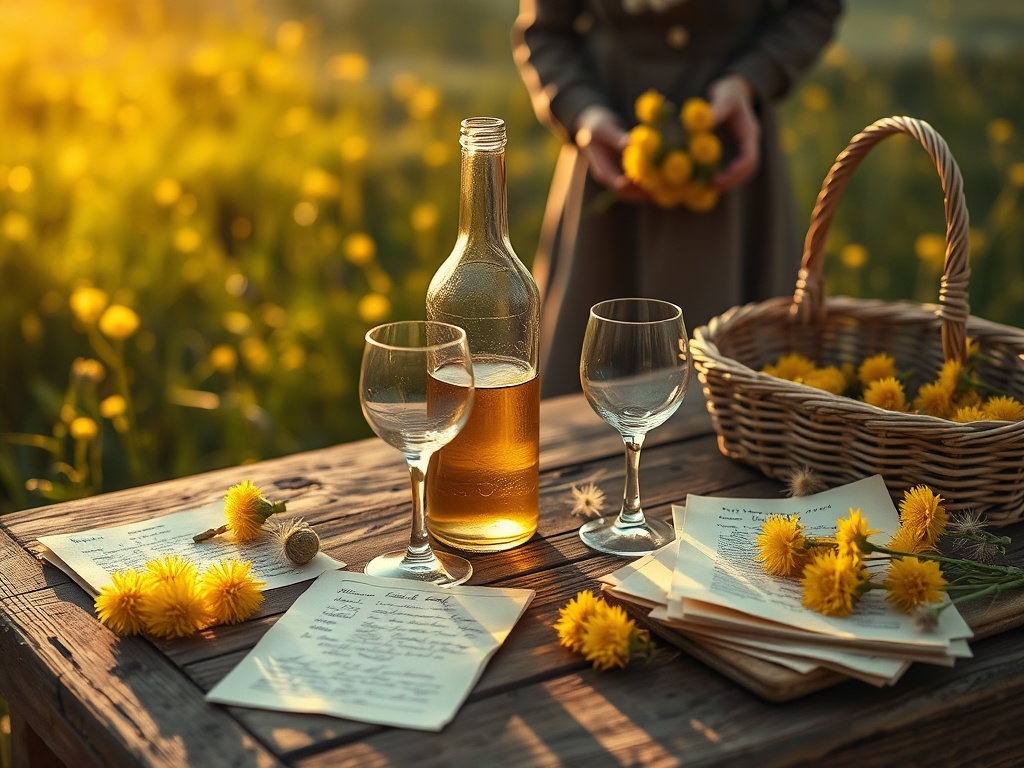
There’s something deeply satisfying about transforming a common yard “weed” into something precious. The Easy Dandelion Wine Recipe offers more than just a unique drink—it provides a tangible connection to historical kitchen crafts that are rapidly disappearing in our fast-paced world. When my neighborhood had an overabundance of dandelions last spring, we organized a community harvesting day that turned into an unexpectedly meaningful gathering.
This golden drink offers a taste of history and herbal wisdom that our great-grandmothers understood intuitively. The satisfaction comes from the complete transformation process—from collecting bright yellow flowers on a sunny morning to sipping the finished product months later. Each step connects you to seasonal rhythms in a way that’s increasingly rare in modern life.
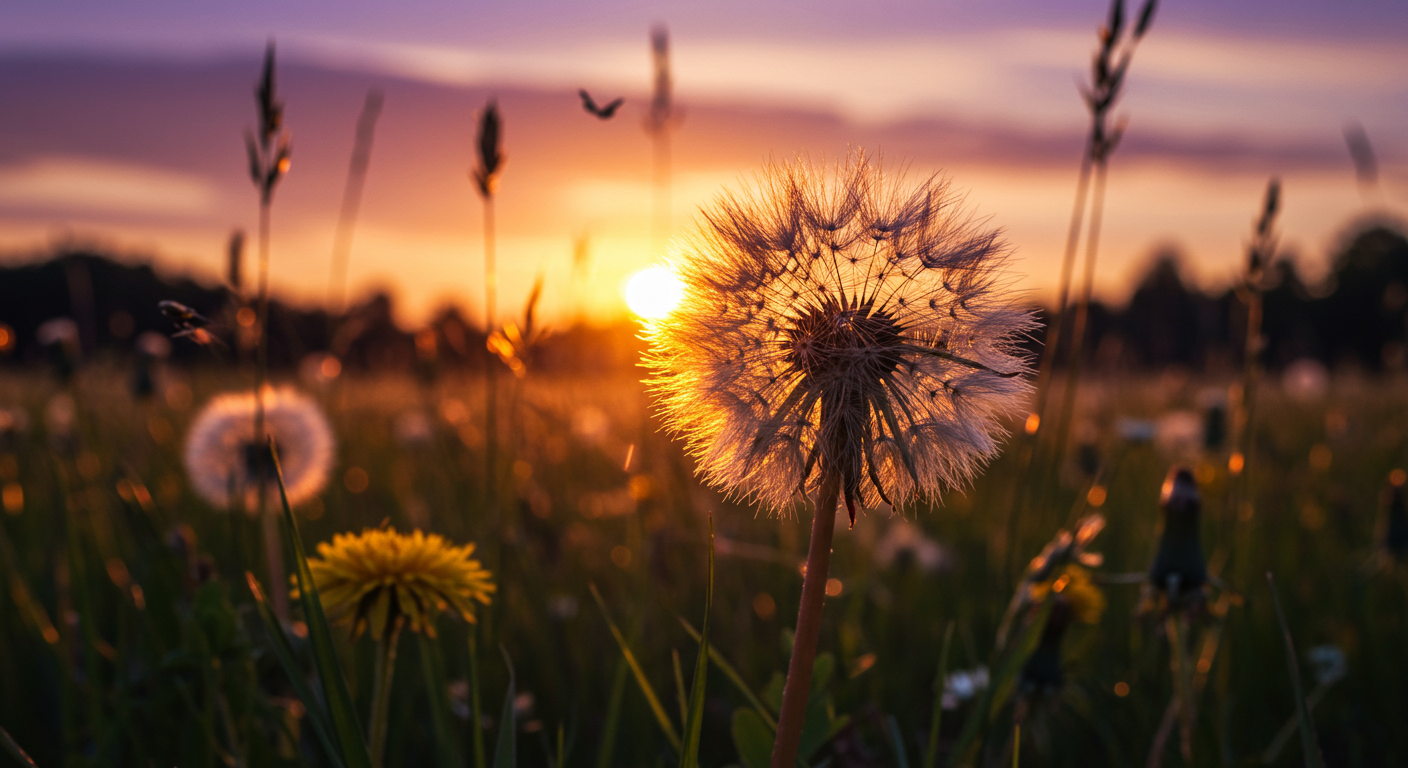
Unlike mass-produced wines, dandelion wine has a subtly sweet, slightly wild flavor profile you simply cannot find on store shelves. It reminds us to slow down and pay attention to the natural world—just like generations before us did when those yellow blooms first appeared each spring. Making this wine isn’t just about the end product; it’s about participating in an ancient wine tradition that turns the everyday into something extraordinary.
Simple Ingredients You’ll Need
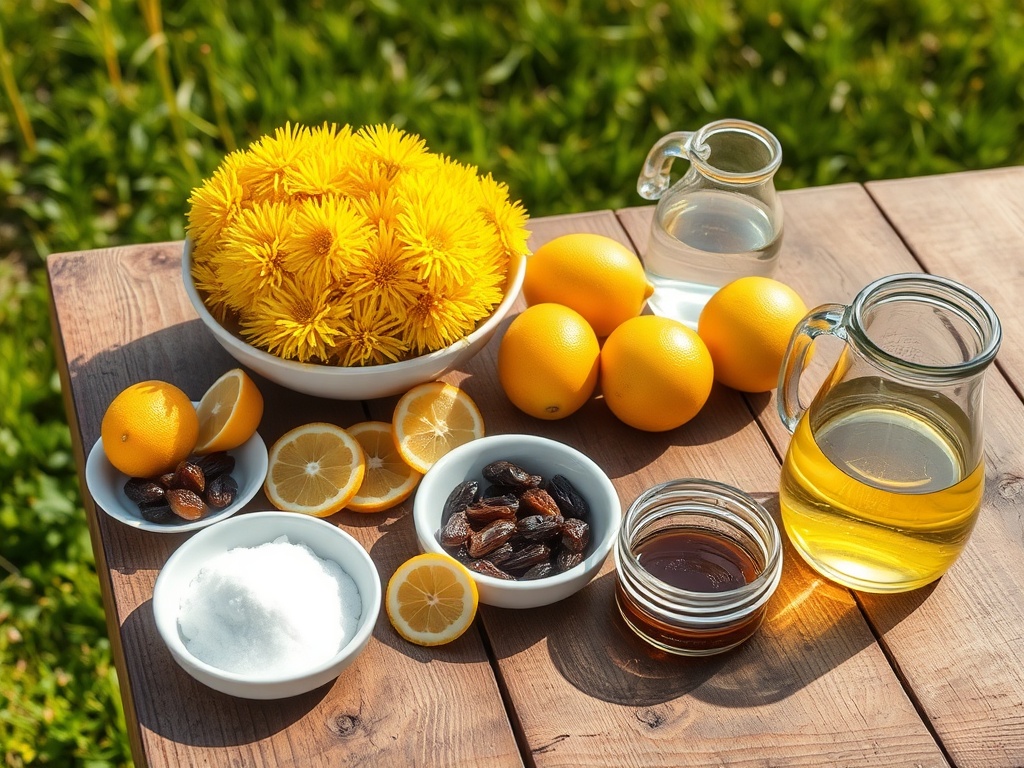
Creating your own batch of dandelion wine requires surprisingly few ingredients. The beauty of this Easy Dandelion Wine Recipe is how it transforms simple, accessible components into something truly special:
| Ingredient | Quantity | Notes |
|---|---|---|
| Dandelion petals | 3–4 cups (just petals) | Best gathered fresh in morning sun |
| Water | 1 gallon | Spring or filtered preferred |
| Sugar | 3 lbs | White or organic cane sugar |
| Lemons | 2, sliced | Adds tart brightness |
| Orange (optional) | 1, sliced | Adds complexity |
| Wine yeast | 1 packet | Champagne or brewer’s yeast works well |
The first time I made this wine, I was shocked by how these everyday ingredients created something so complex. The quality of your petals matters—pick from areas free of pesticides, away from roadsides, and preferably on a sunny morning when the flowers are fully open. My neighbor uses organic cane sugar instead of white sugar and swears it adds depth to the final flavor.
This low-maintenance recipe doesn’t require fancy equipment either. Basic kitchen tools—a large pot, strainer, funnel, and glass bottles or jars with airlocks—are all you need to start your fermentation journey. The combination of fresh ingredients and natural fermentation creates something truly memorable from items most of us already have in our pantries and backyards.
How to Make Dandelion Wine (Step-by-Step)
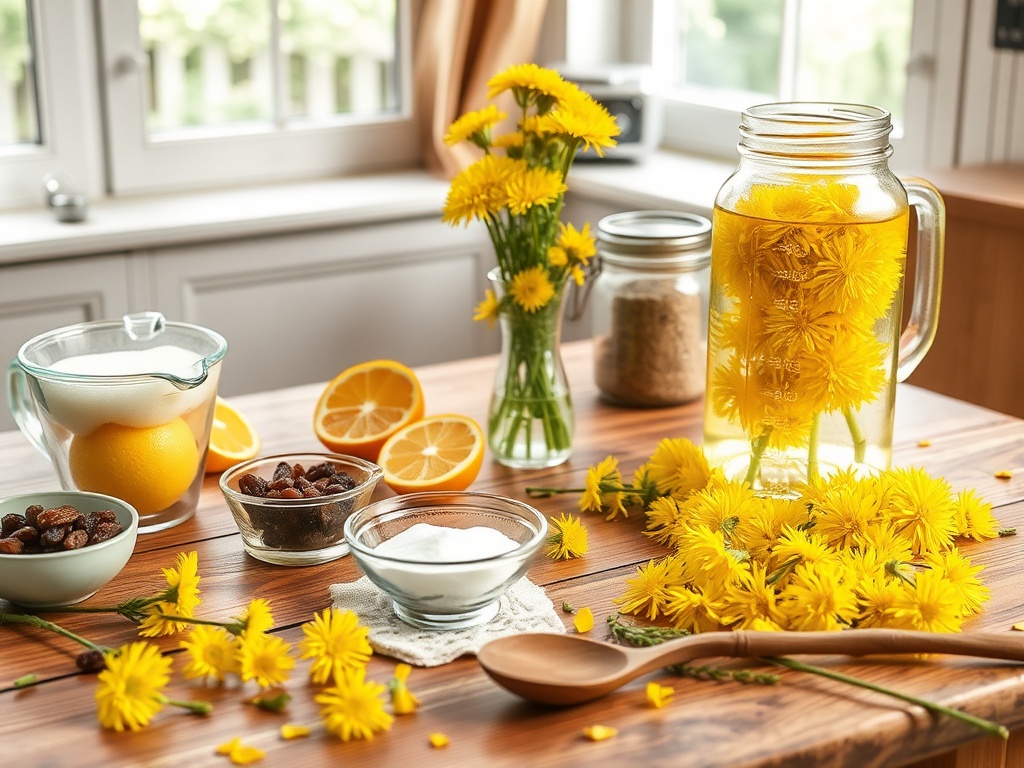
Follow this straightforward process to create your own batch of golden sunshine in a bottle:
🌼 Harvesting Your Dandelions
- Pick flowers in mid-morning sunshine, after dew dries but before petals close up
- Select only fully opened flowers from pesticide-free areas
- Carefully snip petals away from green bases to avoid bitterness
- Aim for about 3-4 cups of clean yellow petals
The first time I harvested with my sister, we made the mistake of including the green parts—don’t do this unless you enjoy extremely bitter wine! We’ve learned to pinch off just the yellow parts, leaving the green base behind. This takes time but dramatically improves flavor.
🌼 Steeping the Petals
- Bring 1 gallon of water to a boil in a large non-aluminum pot
- Remove from heat and add all your dandelion petals
- Cover and let steep for 24–48 hours at room temperature
- The liquid will develop a golden yellow color
During this steeping phase, I like to give the mixture a gentle stir twice a day. The aroma that fills your kitchen during this phase is incredible—earthy, floral, and surprisingly pleasant. My apartment neighbors always knock on my door asking what that amazing smell is!
🌼 Straining & Mixing
- Strain the liquid through a fine mesh sieve or cheesecloth
- Return liquid to a clean pot and add sugar, bringing to a gentle boil
- Stir until sugar completely dissolves
- Add sliced lemons and oranges
- Let cool to lukewarm (about 70-80°F)
- Add wine yeast according to package instructions
This part reminds me of making homemade apple wine—the careful balance of sweetness and acidity that forms the foundation of any good wine. The citrus components add brightness that balances the floral notes perfectly.
🌼 Fermentation & Bottling
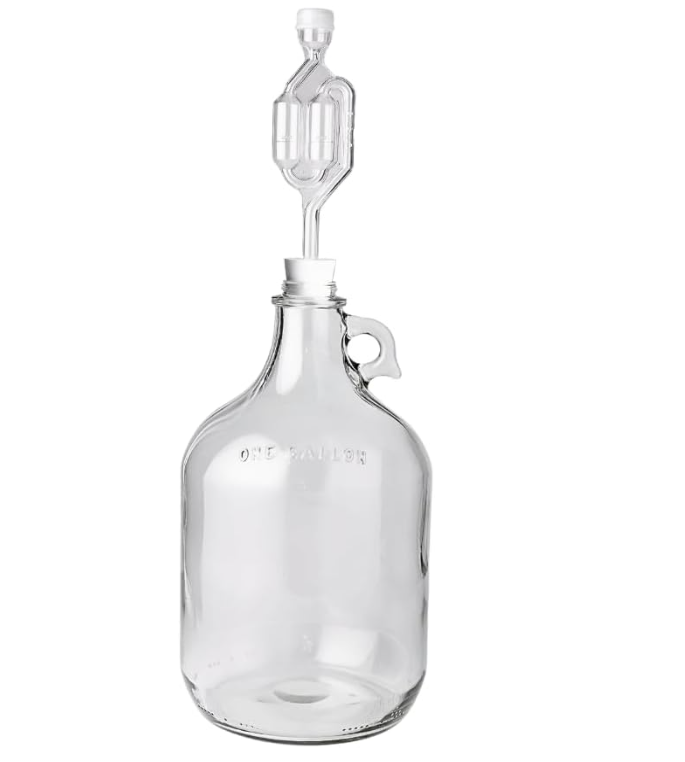
- Transfer mixture to a sanitized glass jug or carboy
- Attach an airlock to prevent contamination while allowing gases to escape
- Store in a dark, cool spot (60-70°F) for 2–3 weeks
- Once active bubbling stops, siphon carefully into clean bottles
- Age for at least 2–6 months (longer is better)
Patience truly pays off with this Easy Dandelion Wine Recipe. My first batch tasted harsh after just one month, but by six months it had transformed into something smooth and complex. The longer you can resist opening those bottles, the better your wine will be!
Flavor Notes & Serving Tips
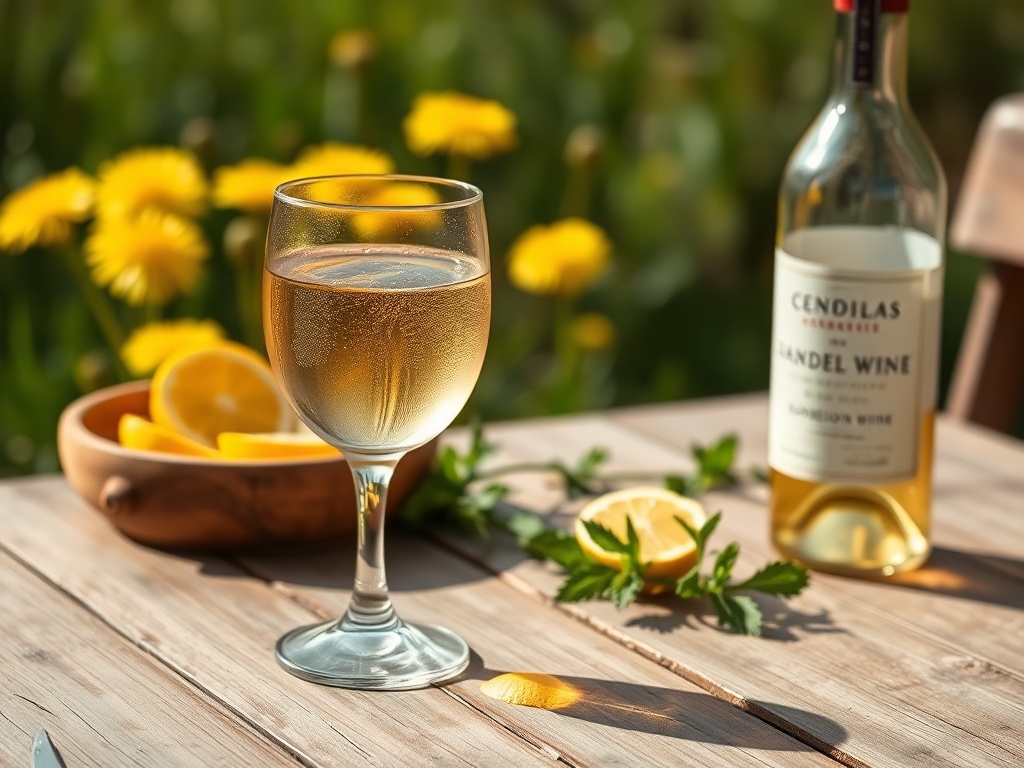
When made properly, this Easy Dandelion Wine Recipe creates a beautifully complex beverage with distinctive character. The flavor profile includes:
- A delicate balance between sweet and slightly bitter notes
- Pronounced floral undertones with hints of honey
- A subtle earthiness that grounds the brighter flavors
- Citrus notes from the lemon and orange additions
- A light body similar to a Riesling or light mead
I’ve found dandelion wine pairs beautifully with tangy goat cheese, light desserts containing almonds or honey, and simple herb-forward dishes. The subtle floral notes complement rather than overpower food, making it surprisingly versatile.
For the best experience, serve dandelion wine well-chilled in small glasses—think sherry or dessert wine portions. My friend Julie hosts an annual spring gathering where we sip last year’s dandelion wine while collecting flowers for this year’s batch—a beautiful seasonal wine tradition that celebrates the full circle of the process.
Consider this a slow-sipping conversation wine rather than something to gulp down. Its unique character invites questions and storytelling, making it perfect for intimate gatherings where you have time to appreciate subtle flavors.
Flavor Variations To Try
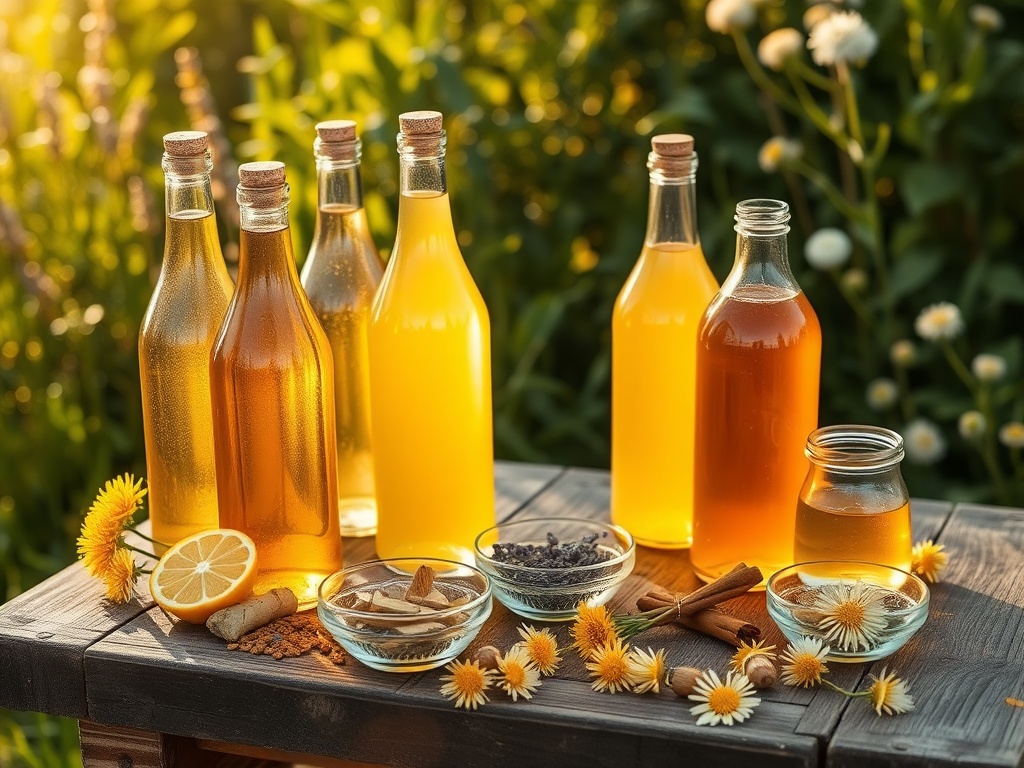
Once you’ve mastered the basic Easy Dandelion Wine Recipe, consider these creative variations to develop your own signature brew:
- 🌿 Add a thin slice of fresh ginger or 2-3 whole cloves during the sugar-boiling phase for a warming spice note
- 🌼 Replace regular sugar with raw honey (reduce to 2-2.5 lbs) for a mead-like quality with additional floral depth
- 🍃 Include a handful of chamomile flowers or elderflower blossoms with your dandelions for layered floral complexity
- 🍊 Use Meyer lemons instead of regular lemons for a softer, more aromatic citrus balance
- 🌱 Add a cinnamon stick and a few cardamom pods for a mulled wine-inspired variation perfect for fall and winter
My personal favorite variation includes a tablespoon of dried lavender buds added during the steeping phase. This creates an incredible aroma and subtle flavor that reminds me of Provence. The beauty of this recipe is its flexibility—you can tailor it to your taste preferences or what’s growing in your garden.
Just like with mulberry wine, each batch becomes a unique expression of your ingredients and timing. Don’t be afraid to experiment with smaller batches to discover your perfect combination. Just remember to keep notes on what you add so you can replicate your successes!
Where to Buy Dandelion Wine if You’re Not Ready to DIY
If you’re curious about the flavor but not quite ready to commit to making your own, several small producers offer artisan-crafted dandelion wines:
- Hidden Legend Winery – This Montana-based meadery produces a floral-forward dandelion wine that captures the essence of traditional recipes. Their small-batch approach ensures quality and authentic flavor.
Website: https://www.hiddenlegendwinery.com/product/dandelion-wine/ - Linganore Winecellars – Located in Maryland, they offer seasonal releases of dandelion wine among their herbal wine collection. Their version tends to be slightly sweeter with pronounced honey notes.
Website: https://www.linganorewines.com/ - Meadowhawk Mercantile – This artisanal Etsy shop specializes in small-batch herbal products, occasionally offering dandelion wine when in season. Their bottles often feature beautiful hand-drawn labels.
Website: https://www.etsy.com/shop/MeadowhawkMercantile
Purchasing a bottle first can give you a good sense of what you’re aiming for with your own Easy Dandelion Wine Recipe. My cousin bought a bottle from Hidden Legend before attempting her own, which helped her understand the target flavor profile. Commercial versions tend to be more consistent but often lack some of the wild character that makes homemade versions special.
These small producers typically release their dandelion wines seasonally, so you may need to join waiting lists or check their websites regularly. Consider it research for your eventual homemade version—a delicious kind of homework!
Storage and Safety Tips for Homemade Herbal Wine
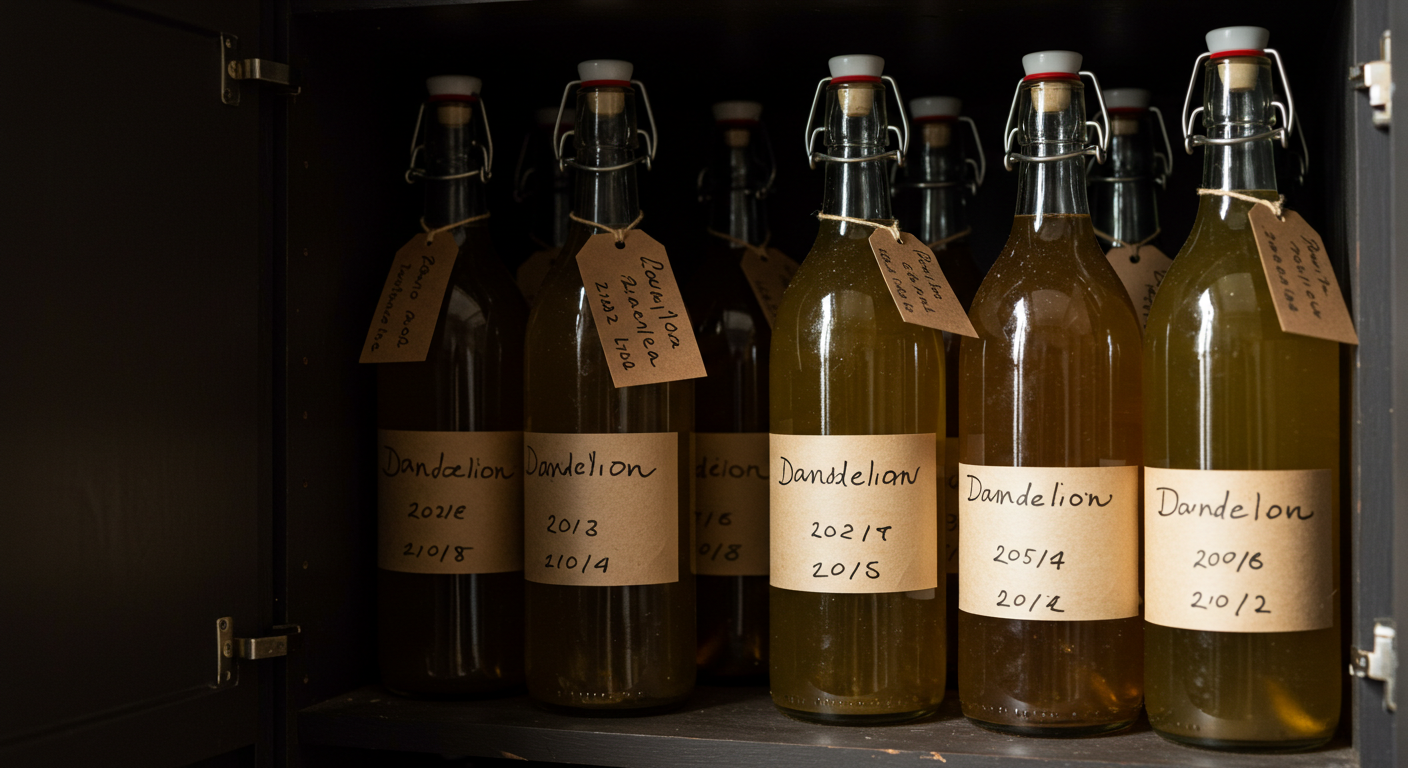
Proper storage and sanitation are crucial for successful dandelion winemaking. Follow these guidelines to ensure your Easy Dandelion Wine Recipe yields safe, delicious results:
- Always sterilize all equipment—bottles, stoppers, funnels, and tools—using brewing sanitizer or a diluted bleach solution (rinse thoroughly)
- Store fermenting wine away from direct sunlight in a temperature-stable environment
- Keep finished wine in a cool, dim space between 50-60°F if possible
- Use clear glass bottles to monitor clarity and sediment development
- Consider a mix of cork and screw-top bottles for different aging timeframes
- Label everything with the batch date and any special ingredients
The first time I made dandelion wine, I skipped proper sanitization and ended up with cloudy, off-tasting wine. Now I’m religious about cleaning everything that touches the brew. This simple step dramatically improves your success rate and ensures food safety.
Aging is another crucial factor—dandelion wine needs at least 2 months to develop properly, but 6-12 months will reward you with significantly improved flavor. My grandmother’s rule was to make wine when the dandelions bloom and drink it during the next year’s bloom—a full cycle that allows maximum flavor development.
If you notice any signs of mold, unusual colors, or strong vinegar smells, it’s best to discard that batch. Food safety always comes first, even with traditional recipes!
Bottling Spring’s Essence: The Joy of Dandelion Winemaking
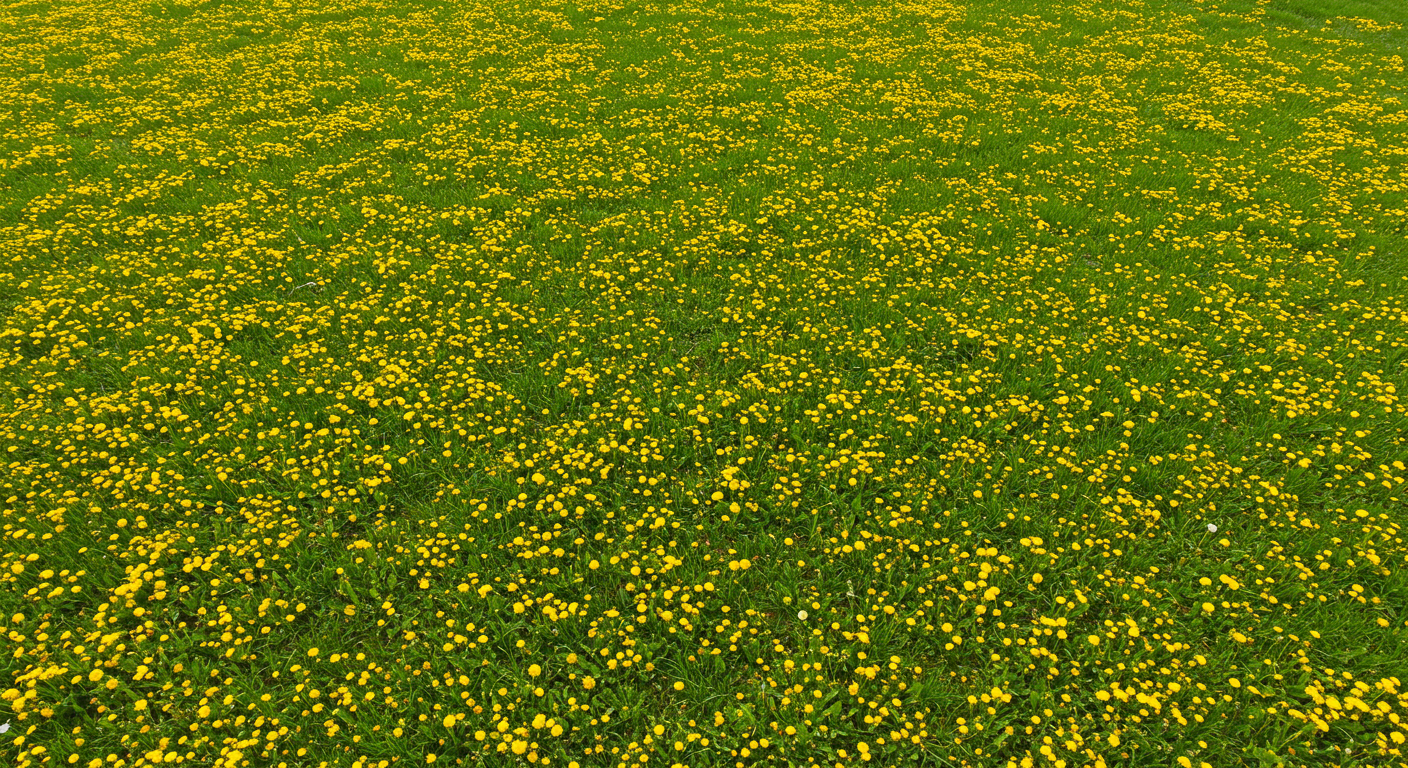
From backyard brewers to herbalists reviving traditional techniques, dandelion wine captures something special about connecting with seasonal abundance. This Easy Dandelion Wine Recipe transforms a humble yard weed into something worth savoring—a true alchemical process that turns the ordinary into gold.
What makes this recipe particularly special is how it forces you to slow down and notice nature’s timeline. You can’t make dandelion wine in winter or fall—you must show up when the flowers do, creating a meaningful ritual of seasonal awareness. In our disconnected world, these small acts of attention matter tremendously.
My family now looks forward to our annual dandelion wine weekend each spring. We gather flowers together, share stories of previous batches, and open bottles from years past to compare. This tradition has become more valuable than the wine itself—though the golden, floral liquid certainly adds to the celebration!
Whether you’re drawn to dandelion wine for its unusual flavor, its connection to folk traditions, or simply as a fun way to use abundant spring flowers, the process offers rewards beyond the bottle. And if your first batch isn’t perfect? That’s part of the journey too. Each year brings new flowers, new knowledge, and new opportunities to perfect your own version of this ancient recipe.




